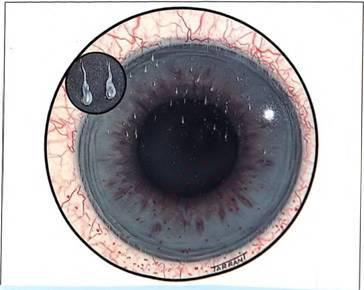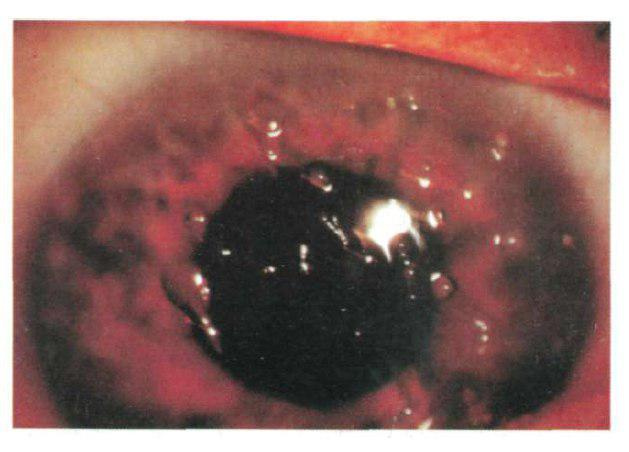Eye reactions to different programs of the psyche, and what you need to know in everyday life

The eye is controlled by the brain through the nerve system. What happens on the lower levels of our psyche (reflexively) determines how the eye will move. But signals can come from different layers with different priorities: for example, when you are sitting at a computer, there are three priorities: “close monitoring mode” (from the point of view of biology, you hunt and you can’t blink), “normal eye moisturizing mode” and “ visual field cleaning mode. "
The main program of the psyche is hunting. Therefore, when you focus at the same distance from the eye, a very ancient mechanism is activated to ensure the continuity of the visual flow. It is more important than moisturizing the eye, so the eye dries - but on the hunt it is uncritical. When it becomes uncomfortable, vision deteriorates, and a “cleaning reflex” is triggered, that is, another part of the brain sends a command to blink so that it does not become worse visible.
Thus, you blink for another reason, not like in ordinary life - and this happens much less often.
Below I want to talk about fairly general, but not always obvious things for my patients. And also about where the different recommendations come from. I’m an optometrist, today I’ll try to talk about the innervation of the eye and tear replacement. In the research direction, we work with the eyes in intensive care, with severe systemic diseases of the body (including in children), plus I just accept as a doctor.
The normal blink rate is about once every 3-4 seconds. These are natural movements, you don’t even notice them. These movements spread a tear over the eye, and thereby make its surface smoother and more protected. If you don’t blink for a long time, or if you blink with a dry eye only because of the reflex of discomfort - “purification of the visual field”, then even this could happen:

Epithelial filaments on the anterior surface of the cornea, characteristic of "filamentous" keratitis.
These vertical stripes in the photo are traces of damage to the corneal epithelium in CVH. The free end of such a thread shifts along the cornea when blinking and irritates the eye, which is accompanied by photophobia, lacrimation and the desire to close the eyes, as a rule, without pronounced inflammatory changes. In place of torn threads, erosive sections of the cornea are formed. The result can be deplorable both in terms of the perspectives of the patient's vision (if you do not perform a complex operation, there will always be blurred vision), and in terms of finding the causes of such damage. In fact, this is a severe or terminal stage of CVH, which means a serious pathology somewhere else in the body. But this is a rare case, usually, of course, we are talking about discomfort, burning in the eyes or tears in the corners of the eyes after 6-8 hours of working at the computer.
Actually, to bring down the hunting mode, and you need to get up from the computer. Theoretically, systems with two screens at different distances can help, progressive lenses of different types (so that the focal length is constantly changing), plus there are Japanese glasses that gradually darken and brighten when blinking - they allow you to start the forced blinking reflex by shading the field of view more often. But they did not receive wide distribution, and even samples for research did not arrive to us. In general, it is better to get up. My recommendation is to go and take a couple of sips of water at least. Make such a habit, and it will be much easier for the eyes.
The same hunting mode is activated for drivers.
Another very ancient reflex is tears as a result of stress. Everything is very interesting here. In a non-standard situation in an animal, one of two systems of reflexes is switched on - the “hit or run” reaction (this is the official name) or the “hide and think” reaction (this is unofficial). The first one releases hormones like adrenaline and norepinephrine into the bloodstream, briefly increases muscle tone, redirects blood flow to maintain the motor system, briefly boosts the immune response - all in order to fight and win or run away, and then survive after bites or whatever else happens. Stress redness is part of this complex. The second set of reactions involves minimizing activity and redirecting priorities to sensory systems, to the brain to think about the situation (if it is sufficiently developed in the species), and so on. Stamina is enhanced, blood flow is often removed from the outside. When we fade during stress, that’s it. They say that some Roman commander selected evil blushing fighters for the first line, and turning pale, who needed to hold out the remainder of the battle, after they killed each other in the first rows, set them down.
After these complexes of reactions there will be time to cry. This is the very reaction to stress that protects the eyes. After any bad situation, our ancestors had to protect the main organs. Eyes are an important organ (we get 80% of environmental information from it), and although they are duplicated, losing even 1 of them is not very profitable. It was more profitable to have a small organ that increased their protection. This is the lacrimal gland, where a supply of fluid is generated for basic protection - abundant eye wash. Typically, this is a universal response to a wide variety of injuries in the wild. If he did not help, then little else would help.
We have this reaction left. And iron, too. There is a common myth - it is about the fact that, perhaps, it is worth putting nearby onions. Like, peeling onions and crying is good. No, even with severe dystrophy, such hydration will not particularly help. The fact is that a tear accumulates in the lacrimal gland for this type of reaction. The usual tear film is secreted by other glands (mainly meibomian). It is it that is used to lubricate the eye and create a protective and optical layer. Here a colleague talks in more detail. That is, crying and normal eye hydration are two different things. That is why a tear production test without an anesthetic is far from always indicative: we do not know how much the patient excreted due to pain in the eye from a strip of dough and how much fluid came out of other glands.
The third important thing is adaptation to discomfort. Our body flexibly adjusts to environmental conditions. If you develop pain sensitivity in the hand-to-hand training (“stuff” the main zones), there will be physiological changes in terms of muscle gain or skin build-up, and the brain will at the same time learn to filter the pain signal, reducing its value precisely from these sections of nerves. The same thing happens with the eyes.
In practice, this means that if you often wear contact lenses, sensitivity is lost both on the nervous network (less data comes from the eye) and on filtering in the brain (discomfort is given less importance). The result - you can wear grains of sand in the eye or not feel something getting into the eye and so on. Blocking a pain signal (the body’s internal information system) rarely leads to something good.
The second consequence: if you are on tear replacement therapy and often use drops, the body can rebuild and begin to produce less of its own tears. Because it is already taken from somewhere. The threshold is somewhere at the level of 20 applications per day for two months (studies have not been carried out, this is my accumulated data without detailed verification). At 6–7 applications per day, it almost certainly does not react.
At the same time, if you are constantly in a humid environment (for example, an air humidifier is working), no similar adaptation processes will start, and the production of tears will not decrease. But if it’s dry (air conditioning or fan heater in the room, chemical laboratory, chemical production, car, plane, not your native dry region) - after a few months you will get used to the discomfort.
That is why after several years of working at a computer, my eyes hurt less. It is not they who cease to hurt, but the signal value is underestimated. Remember your first days - and consider that the eyes provide information in the same way, it’s just filtered. I cannot recommend you as a doctor a medical device without examination, but some of my patients did the following: they took Blefarogel 1 and applied it on the eyelids for several days according to the instructions. If it became easier, they understood that something needs to be done with the eyes further.
Clear symptoms that you need to go to a normal optometrist (it’s better not to go to the district clinic, they often don’t even have contrast for tear film tests - this is not the level of financing), this is dry eyes, or burning eyes, or tears at the end of the day at corners of the eyes (even once). His eyes reddened once - immediately running to the doctor. It accumulates and ends not very well. My patients often make the mistake of going to the pharmacy to complain. A good pharmacist asks a couple of questions and gives a tear substitute or moisturizing drops - this does not solve the problem, but removes the symptoms, and natural regenerative processes that can “stretch” the onset of CVH (dry eye syndrome) are included. They often give a vasoconstrictor to remove redness - it is used only for cosmetic purposes, and the result is only exacerbated. The correct strategy is to clean the ducts of the meibomian glands (anti-inflammatory and moisturizing), but this should already be decided with the doctor. Because the reason is usually not in the eyes, but somewhere in the psyche or background diseases. Another common reason is a significant change in the hormonal background (applies to women at a certain age and adolescents aged 14-15).
Well, the last thing I would like to tell today is about operations and resuscitation. In case of loss of consciousness, the human eye “turns off”, that is, the nerve control signal disappears. When we sleep, we, of course, do not blink, but a tear is created, and the eye moves widely so that it spreads well enough. But when we lose consciousness, this does not happen. This applies to anesthesia - during operations for more than two hours, it is recommended to apply a gel or wet blindfolds. This applies to resuscitation - there patients stay much longer with their eyes half open, just with an open eye or with a closed, but drying. With injuries to the eye or brain, everything is much more complicated there, and a very good moisturizing system is needed. The same applies to medical coma and a number of other conditions.
Everything that I told above is very approximate, and the mechanisms are actually much more complicated. If you are interested in understanding how the eye is structured, I can tell you a lot about innervation and control, plus continue about completely everyday things like the effect of carpets on vision and various underestimated household hazards for the eyes.
